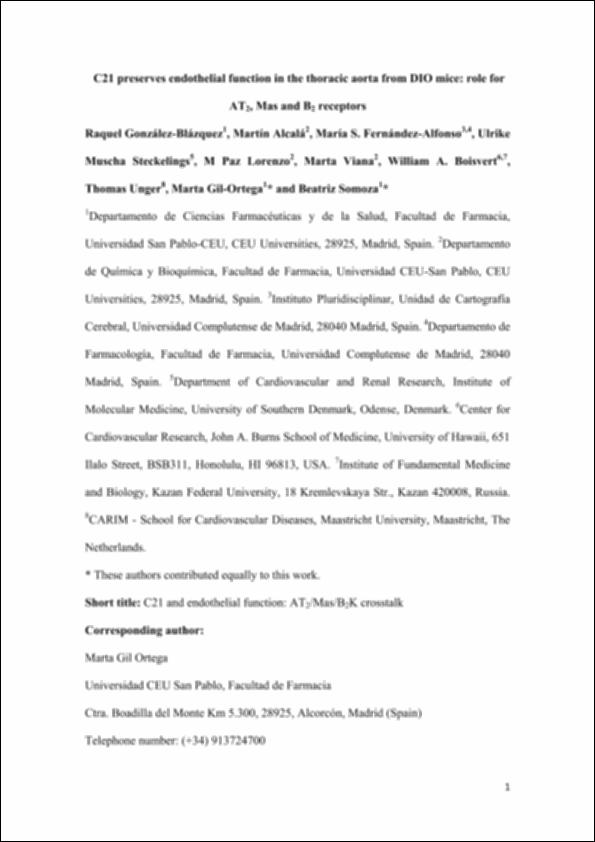Please use this identifier to cite or link to this item:
http://hdl.handle.net/10637/14694C21 preserves endothelial function in the thoracic aorta from DIO mice: role for AT2, Mas and B2 receptors
| Title: | C21 preserves endothelial function in the thoracic aorta from DIO mice: role for AT2, Mas and B2 receptors |
| Authors : | González Blázquez, Raquel Alcalá Díaz-Mor, Martín Fernández Alfonso, María Soledad Muscha Steckelings, Ulrike Lorenzo García, María Paz Viana Arribas, Marta Boisvert, William A. Unger, Thomas Gil Ortega, Marta Somoza Hernández, Beatriz |
| Keywords: | Compound 21; Nitric oxide; Angiotensin II type 2 receptor; Mas receptor; Bradykinin type 2 receptor; Diet-induced obesity |
| Publisher: | Portland Press |
| Citation: | Raquel González-Blázquez, Martín Alcalá, María S. Fernández-Alfonso, Ulrike Muscha Steckelings, M. Paz Lorenzo, Marta Viana, William A. Boisvert, Thomas Unger, Marta Gil-Ortega, Beatriz Somoza; C21 preserves endothelial function in the thoracic aorta from DIO mice: role for AT2, Mas and B2 receptors. Clin Sci (Lond) 14 May 2021; 135 (9): 1145–1163. doi: https://doi.org/10.1042/CS20210049 |
| Abstract: | Compound 21 (C21), a selective agonist of angiotensin type 2 receptor (AT2R), induces vasodilation through NO release. Since AT2R seems to be overexpressed in obesity, we hypothesize that C21 prevents the development of obesity-related vascular alterations. The main goal of this study was to assess the effect of C21on thoracic aorta endothelial function in a model of diet-induced obesity and to elucidate the potential crosstalk between AT2R, MasR and/or B2R in this response. 5-week-old male C57BL6J mice were fed a standard (CHOW) or a high-fat diet (HF) for 6 weeks and treated daily with C21 (1mg/Kg p.o) or vehicle, generating four groups: CHOW-C, CHOW-C21, HF-C, HF-C21. Vascular reactivity experiments were performed in thoracic aorta rings. Human endothelial cells (EA.hy926) were used to elucidate the signaling pathways, both at receptor and intracellular levels. Arteries from HF mice exhibited increased contractions to Ang II than CHOW mice, effect that was prevented by C21. PD123177, A779 and HOE-140 (AT2R, Mas and B2R antagonists) significantly enhanced Ang II-induced contractions in CHOW but not in HF-C rings, suggesting a lack of functionality of those receptors in obesity. C21 prevented those alterations and favoured the formation of AT2R/MasR and MasR/B2R heterodimers. HF mice also exhibited impaired relaxations to acetylcholine due to a reduced NO availability. C21 preserved NO release through PKA/p-eNOS and AKT/peNOS signaling pathways. In conclusion, C21 favours the interaction between AT2R, MasR and B2R and prevents the development of obesity-induced endothelial dysfunction by stimulating NO release through PKA/p-eNOS and AKT/p-eNOS signaling pathways. |
| Description: | Este artículo es la versión preprint, siguiendo la política de acceso abierto de la editorial Portland Press |
| URI: | http://hdl.handle.net/10637/14694 |
| Rights : | http://creativecommons.org/licenses/by-nc-nd/4.0/deed.es |
| ISSN: | 1470-8736 |
| Issue Date: | 11-May-2021 |
| Center : | Universidad San Pablo-CEU |
| Appears in Collections: | Facultad de Farmacia |
Items in DSpace are protected by copyright, with all rights reserved, unless otherwise indicated.


